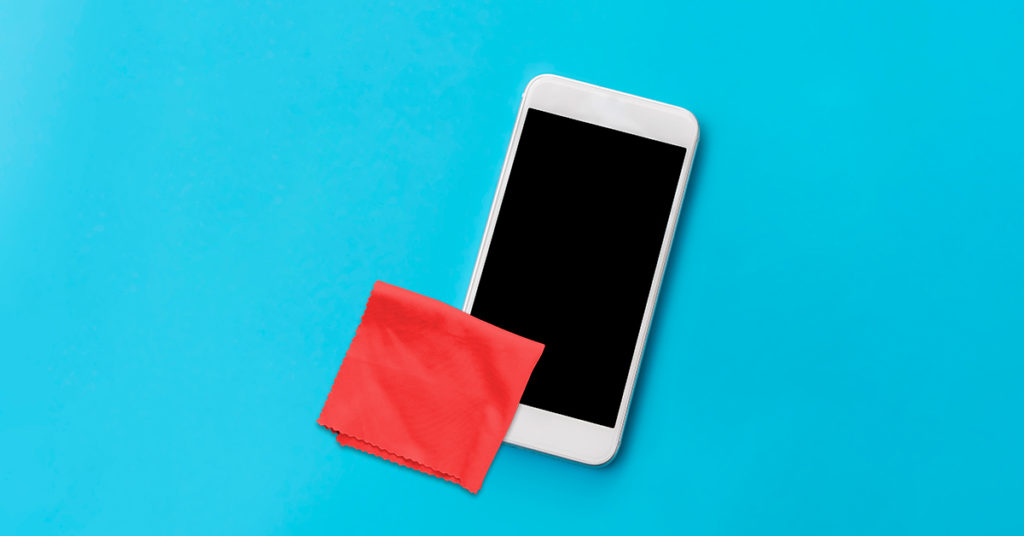
How Do You Keep All Your Tech Gadgets Clean?
Our tech gadgets get dirty, just like our clothes and our dishes. And you can’t throw them in the washer or a sink full of suds, so you’re probably unsure of how to get them clean. Or worse, you’re afraid of ruining your expensive technology with the wrong cleaning product. Here’s how you can safely remove dirt and sanitize your phone, computer and other electronic devices safely.
General rules for cleaning your tech gadgets
Wash your hands before you start. Clean hands keep you from re-introducing dirt and germs to your freshly cleaned device.
Avoid using household cleaners. They can be too harsh and may easily scratch surfaces or damage protective coatings.
Power down and unplug your device. Even though you’ll be using a minimal amount of liquid (if you use any at all), there’s still a small chance of electric shock. It’s also easier to see dust and spots on a black, unlit screen.
Use microfiber cloths. Paper towels and cotton cloths leave tiny fibers (lint) behind. Lint may also cause an electrostatic charge that can damage the device. Lint-free microfiber cloths are absorbent and designed to attract dirt and dust without leaving particles behind. Made from synthetic fibers, these soft cloths are great for wiping down almost any electronic device.
Set aside a time every week to clean. The end of your work week is a great time to sanitize. If you make cleaning your devices a weekly habit, you’ll avoid buildup of dust, fingerprints and, for some, cookie crumbs.
Cleaning and sanitizing your smartphone
Think of all the oil or makeup from your face that can accumulate on your phone screen, along with bacteria from your hands and from the not-so-clean places where you put your phone down. When you pick up your phone, all that gunk comes into contact with your skin, which can result in breakouts or bacterial infections. The FCC recommends you clean your phone daily.
Wipe your phone with a dry microfiber cloth. Before wiping, you can lightly moisten the microfiber cloth with 70% isopropyl alcohol (which is the plain old drugstore rubbing alcohol used on cuts and scrapes) to help remove germs and bacteria. Never spray alcohol directly onto your phone as it can enter phone ports or jacks and cause damage. You can use disinfecting wipes that contain the same 70% isopropyl alcohol as long as they don’t contain bleach. Be sure to wring out any excess moisture before using. Don’t use hand sanitizer to clean your phone. While it’s great for killing germs on skin, these products often contain fragrances or moisturizers that can leave residue behind.
Try a UV light sanitizer. In the age of coronavirus, there has been a flurry of new UV sanitizers entering the market that claim to disinfect your phone and kill the virus. PhoneSoap offers small units into which you can place your phone and a larger size for most other gadgets to safely sanitize them with UVC light in a matter of minutes. While these devices will kill the majority of germs and bacteria on your phone, they have not been proven to kill the Covid-19 virus (although scientists believe that, in theory, they should).
Cleaning your smart speakers
You can use a microfiber cloth on the hard plastic surfaces, either dry or lightly dampened with 70% isopropyl alcohol. For the mesh or fabric areas, small vacuum attachments will help to remove dust. A toothpick can be gently used to dislodge stubborn dirt.
Use a blow dryer on low speed for the seams and around the buttons. Don’t use canned compressed air on these devices, especially on mesh and fabric areas, as the force of the air could damage the internal workings of the speaker. A cloth that has been slightly moistened with water can be used to remove tougher stains. Use your judgment. Depending on how long it’s been between cleanings, you may have to do several rounds of scrub, dry, repeat. Allow the speaker to dry completely before turning it back on.
Cleaning your wearable gadgets
Wearable devices, such as smartwatches and fitness trackers, can harbor bacteria from sweat that that can irritate your skin, especially if you exercise while wearing them.
Rinse them off with water and pat dry. While you shouldn’t submerge them in water (unless the manufacturer recommends it), a quick rinse should be fine. A microfiber cloth sprayed with isopropyl alcohol can be used on the face and on sport or metal bands. Rubber straps can be rinsed in water without soap, while nylon and silicone bands can be washed in soapy water. Leather straps should be wiped down with a dry cloth as these can be easily damaged by water or alcohol. Allow everything to dry thoroughly.
Cleaning your laptop and keyboards
Dust and other particles can easily get into the tiny slots of keyboards, so be sure to give them a weekly cleaning.
First, dust the screen. A dry microfiber cloth works great for dusting screens, and again, our friend the cloth dampened with 70% isopropyl alcohol will remove spots and streaks as well as kill bacteria.
Turn your keyboard upside down to clean. When cleaning your laptop keyboard or a separate detachable keyboard, turn it upside down first to remove any loose debris, then give it a few passes with a can of compressed air. The damp cloth with alcohol can be used to clean your keyboard, too. Make sure the cloth is damp, not wet, as you don’t want to get moisture inside the keyboard. If you’ve ever spilled liquid into a laptop or keyboard, you know there is no faster way to cause permanent damage to an electronic device.
Use a moistened cotton swab on mechanical (raised key) keyboards. These will help you get in between the keys where a cloth might not reach. If possible, remove the keys for a deeper cleaning, but check with the manufacturer’s directions first. If that makes you uncomfortable, you can try a DIY cleaning slime, an effective way to get into hard-to-reach areas between the keys. Cleaning slime removes dust and dirt from calculators, adding machines and office phones, too. Be sure to let everything dry completely before powering up.




Join the conversation